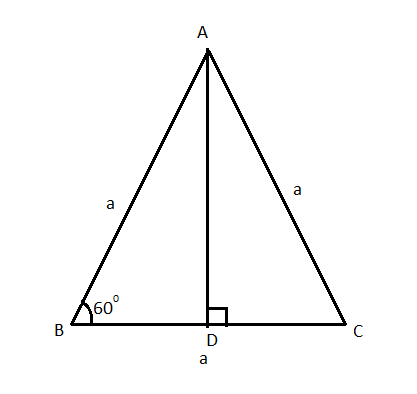
In an equilateral triangle, prove that three times the square of one side is equal to four times the square of one of its altitude.
Answer
595.8k+ views
Hint: Here, we will first assume that the length of the sides of the equilateral triangle is equal to ‘a’ units. Then, we will drop an altitude from a vertex to one of its sides and find its length to prove the given statement.
Complete Step-by-Step solution:
Consider a triangle ABC which is equilateral.

Let us assume that the length of each side of the equilateral triangle is ‘a’ units.
Drop a perpendicular AD from the A on the side BC of the triangle.
Since AD is perpendicular to BC, we can say that $\angle ADB={{90}^{0}}$.
Also, as ABC is an equilateral triangle, so all the sides are of equal length and all the angles are equal to 60 degrees.
Therefore, AB = a units and $\angle ABC={{60}^{0}}$.
Now, according to the angle sum property of the triangle, the sum of all the angles of a triangle is equal to 180 degrees.
So, in triangle ABD, we can write:
$\begin{align}
& \angle ABD+\angle ADB+\angle BAD={{180}^{0}} \\
& \Rightarrow {{60}^{0}}+{{90}^{0}}+\angle BAD={{180}^{0}} \\
& \Rightarrow {{150}^{0}}+\angle BAD={{180}^{0}} \\
& \Rightarrow \angle BAD={{180}^{0}}-{{150}^{0}}={{30}^{0}} \\
\end{align}$
We know that for any angle $\theta $ , we have:
$\cos \theta =\dfrac{\text{length of base}}{\text{length of hypotenuse}}$
So, in triangle ABD, we can write:
\[\begin{align}
& \cos \left( \angle BAD \right)=\dfrac{AD}{AB} \\
& \Rightarrow \cos {{30}^{0}}=\dfrac{AD}{AB} \\
& \Rightarrow \dfrac{\sqrt{3}}{2}=\dfrac{AD}{a} \\
& \Rightarrow \sqrt{3}a=2\times AD \\
\end{align}\]
On, squaring both sides, we get:
$\begin{align}
& {{\left( \sqrt{3}a \right)}^{2}}={{\left( 2\times AD \right)}^{2}} \\
& \Rightarrow 3\times {{a}^{2}}=4\times A{{D}^{2}} \\
& \\
\end{align}$
Here, we can see that a is the length of one of the sides of the equilateral triangle and AD is the length of the altitude. So, we can write as:
$3\times {{\left( \text{length of one side} \right)}^{2}}=4\times {{\left( \text{length of altitude} \right)}^{2}}$
Hence, we have proved that three times the square of one side in an equilateral triangle is equal to four times the square of one of its altitudes.
Note: Students should note here that in an equilateral triangle, the measure of each of the angles is 60 degrees. Students should also know about the angle sum property of a triangle in order to find the value of an unknown angle. Here, one can also use other trigonometric ratios instead of cosine to arrive at the required conclusion.
Complete Step-by-Step solution:
Consider a triangle ABC which is equilateral.

Let us assume that the length of each side of the equilateral triangle is ‘a’ units.
Drop a perpendicular AD from the A on the side BC of the triangle.
Since AD is perpendicular to BC, we can say that $\angle ADB={{90}^{0}}$.
Also, as ABC is an equilateral triangle, so all the sides are of equal length and all the angles are equal to 60 degrees.
Therefore, AB = a units and $\angle ABC={{60}^{0}}$.
Now, according to the angle sum property of the triangle, the sum of all the angles of a triangle is equal to 180 degrees.
So, in triangle ABD, we can write:
$\begin{align}
& \angle ABD+\angle ADB+\angle BAD={{180}^{0}} \\
& \Rightarrow {{60}^{0}}+{{90}^{0}}+\angle BAD={{180}^{0}} \\
& \Rightarrow {{150}^{0}}+\angle BAD={{180}^{0}} \\
& \Rightarrow \angle BAD={{180}^{0}}-{{150}^{0}}={{30}^{0}} \\
\end{align}$
We know that for any angle $\theta $ , we have:
$\cos \theta =\dfrac{\text{length of base}}{\text{length of hypotenuse}}$
So, in triangle ABD, we can write:
\[\begin{align}
& \cos \left( \angle BAD \right)=\dfrac{AD}{AB} \\
& \Rightarrow \cos {{30}^{0}}=\dfrac{AD}{AB} \\
& \Rightarrow \dfrac{\sqrt{3}}{2}=\dfrac{AD}{a} \\
& \Rightarrow \sqrt{3}a=2\times AD \\
\end{align}\]
On, squaring both sides, we get:
$\begin{align}
& {{\left( \sqrt{3}a \right)}^{2}}={{\left( 2\times AD \right)}^{2}} \\
& \Rightarrow 3\times {{a}^{2}}=4\times A{{D}^{2}} \\
& \\
\end{align}$
Here, we can see that a is the length of one of the sides of the equilateral triangle and AD is the length of the altitude. So, we can write as:
$3\times {{\left( \text{length of one side} \right)}^{2}}=4\times {{\left( \text{length of altitude} \right)}^{2}}$
Hence, we have proved that three times the square of one side in an equilateral triangle is equal to four times the square of one of its altitudes.
Note: Students should note here that in an equilateral triangle, the measure of each of the angles is 60 degrees. Students should also know about the angle sum property of a triangle in order to find the value of an unknown angle. Here, one can also use other trigonometric ratios instead of cosine to arrive at the required conclusion.
Recently Updated Pages
Master Class 12 Business Studies: Engaging Questions & Answers for Success

Master Class 12 Economics: Engaging Questions & Answers for Success

Master Class 12 English: Engaging Questions & Answers for Success

Master Class 12 Maths: Engaging Questions & Answers for Success

Master Class 12 Social Science: Engaging Questions & Answers for Success

Master Class 12 Chemistry: Engaging Questions & Answers for Success

Trending doubts
Who was the first woman to receive Bharat Ratna?

Write a letter to the principal requesting him to grant class 10 english CBSE

Why is there a time difference of about 5 hours between class 10 social science CBSE

What is the median of the first 10 natural numbers class 10 maths CBSE

The Equation xxx + 2 is Satisfied when x is Equal to Class 10 Maths

Discuss the main reasons for poverty in India




